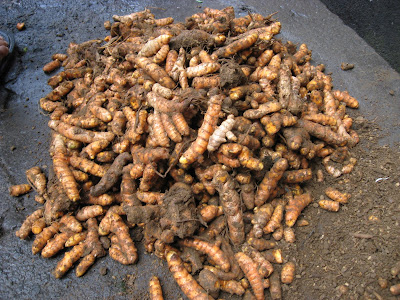After our
beautiful wedding in March, we're back from a wonderful
honeymoon in Bali! And I mean
wonderful.
We spent time in both Seminyak and Ubud and the villas we stayed in were absolute luxury with our own private swimming pools and canopy beds romantically draped with gauzy mosquito nets.
And the people! I’d read everywhere that the Balinese are always smiling, always helpful, always friendly – yes, yes yes, whatever, they’re friendly, I get it – but we weren’t prepared for just how friendly they were.
Of course our culinary adventures were also superb and Bali certainly offers excellent eating whether it's local Balinese, general Indonesian or fab international fusion. I hope to do a few posts about our gastronomic experiences, but to whet your appetite I think I should start with some of the most exquisite dishes I ate in the trip and – even better – they came straight from a cooking class!
When we decided on Bali the first thing I did was investigate which cooking schools were top notch and Casa Luna was raved about in every online and hardcopy guide book. I booked Jonas and I in for a vegetarian cooking class for our very first morning.
Casa Luna is a restaurant, guest house and cooking school of Australian Janet de Neefe who married a Balinese man and got hooked on local food and culture.
Her Honeymoon Guesthouse on Jalan Bisma in Ubud was a beautiful building and the class was conducted on an airy open terrace that looked out across rooftops, shrines and rice fields. It was the perfect setting to learn about Bali’s cuisine, especially in Ubud which is hailed as a stronghold of Balinese culture including food, art and dance.
Before I launch into the dishes, I have to outline a little bit about Balinese cuisine in general. The main flavours are simple, fresh and punchy. The following is what I gleaned from the cooking lesson and my 10 days of three course feasting.
Turmeric and different
gingers (ie galangal or
torch ginger) play a central role and
coconut can be found in various forms: fresh flesh, coconut juice, coconut milk, roasted coconut, coconut sambal.
Tiny
kaffir limes are used for their juice and the leaves are shredded into salads and spice pastes, as is young
lemongrass.
Tamarind provides another sour component to many dishes whereas
palm sugar has a caramel sweetness and is said to add the magic touch to complete any dish.
 |
| Fern shoots |
Belacan, or shrimp paste, is used to provide saltiness and my cheeky Balinese teacher was accurate when she said “
it smells like hell but tastes like heaven”.
Garam (or sea salt) is very mild in Bali and is literally used by the handful rather than the pinch. It has a very elegant flavour which I prize highly.
Kecap Manis is the soy sauce of Indonesia, salty and yet thick and sweet also.
In terms of herbs,
salam is an aromatic herb that’s used in much the same as European cooking employs bay leaves – although the flavour is much more delicate and bays should never be used as a substitute.
Pandan leaves are also used to perfume food, both sweet and savoury, the way vanilla is used in the West.
And one cannot forget the chilli – it plays a huge role in almost all Balinese dishes whether it's included in the cooking or served on the side in a sambal. I learnt that there are three main chillis used: long, red sweet chilli; squat, orangey-green
lombok chilli; and then the tiny
tabia krinyi which are green birds eye bullets that will knock your socks off.
Unfortunately for my curious food blogging pals the recipes from Casa Luna’s cooking class cannot be reproduced without permission from the school, so while I find out whether I can post one or two of my favourites, I’ll tell you about each of the dishes we learned to cook.
We snacked on these crackers while we prepped our dishes for lunch.
 |
| Kare Tempe - Tempeh Curry |
Tempeh in Bali was just so textured and you could see the gorgeous chunky soy beans in the tempeh blocks. In this curry slices of tempeh were paired with sweet choko (chayote) and were flavoured with a gorgeous curry paste made of ginger, galangal, chilli, salam leaves, garlic, coriander seeds, tumeric, candlenut, lemongrass and tamarind. This was fried until fragrant and finished with coconut milk.
 |
| Urab Pakis - Fern Shoot Salad |
Urab is a wonderful discovery for both Jonas and I. It’s a ridiculously delicious salad that alternates the vegetables but always seems to include the same ‘seasoning’ of shredded, roasted coconut and kaffir lime with sambal goreng – a fried chilli sauce of shallots, chilli, garlic and belacan. In this version they used steamed pakis (fern shoots) which tasted like mild baby spinach but looked delightful with their frilly, curly fronds.
 |
| Roasted chilli sambal |
Tomatoes and chillies were roasted with garlic then chopped into this spicy condiment.
 |
| Sambal Tuwung - Roasted Eggplant Sambal |
This refreshing, slippery side dish was made of eggplants roasted with tomato and garlic and then smothered in a sauce of kaffir lime, chilli and palm sugar. They made this with their hands, squishing the tomatoes to create a sauce.
 |
| Kuah Ikan - Fish w Lemongrass & Tomato |
This dish was deliciously light and fragrant but yet the flavours still invaded my mouth and set up an entire civilisation. Mackerel was cooked with a spice paste of garlic, belacan, tomatoes, palm sugar, shallots, chilli, lemongrass and coriander seeds. The dish is also flavoured with torch ginger, coconut milk, tamarind and salam.
 |
| Mee Goreng - Fried Noodles |
A simple, fried noodle dish is always a crowd-pleaser.
I was so sad I didn’t get a photo of the
Rujak (sweet & sour salad) because it was so wonderful although admittedly not very pretty. Apparently this dish is one of the Balinese women and children’s favourite afternoon snacks. It involves steeping chunks of apple, pineapple, jicama and cucumber – or any similar, juicy fruits or vegetables – in a sauce of chilli, tamarind and palm sugar syrup that’s been pounded in a mortar and pestle. The sweet fruit was perfectly matched with the tart, spicy dressing.
 |
| Arak |
We got to eat this amazing feast with a glass of coconut and lemongrass juice spiked with Indonesia’s heady booze,
arak, distilled from rice, coconut and palm.
The
Dadar Unti (green pancakes with coconut) was the best dessert I tasted on my whole holiday and I looked for it everywhere but to no avail. The Casa Luna staff flavoured the batter with pandan leaves and then stuffed the hot crepes with grated coconut that had been caramelised with palm sugar and pandan. It was so divine I ate it all before I took a photo!
I strongly recommend you take a cooking course on any holiday to a new location. It’s such a sensual way to introduce yourself to the new environment, flavours and ingredients and will provide you with a rich knowledge base to explore throughout the remainder of your holiday.
If you’re in Bali, try out Casa Luna’s school or at very least the restaurant!
Tags: morsels and musings food blog food and drink australia recipes bali casa luna ubud tempe tempeh pakis fern shoots ikan urab sambal balinese recipes balinese food balinese cuisine indonesian recipes indonesian food indonesian cuisine










































